|
Vintage Volkswagen Bus Model Descriptions
|
|
Starting in October 1958, Volkswagen attached an "M-Code" plate
to every Type-2 vehicle (i.e., Kombis, Panels, Pickups...) they manufactured.
This plate is a 3 1/2" by 1 3/4" rectangle piece of
metal with a series of letters and numbers stamped into it, that provides a lot of
useful information about when the bus was made,
what country it was exported to, the original interior and exterior colors, optional equipment, the body type, etc. This plate was attached with 2 screws or pop-rivets to the bulkhead panel behind the front passenger's seat (regardless of whether the bus is a bench seat or walkthru model). By deciphering the numbers on your bus's
M-code plate, you can discover a lot about what your bus looked like, when it rolled off the assembly line!
Below is an example of an M-Code Plate (note that this example shows the
numbers highlighted in different colors, but obviously in the real world these numbers are just stamped
into the plate and are not colored at all!). There's a lot to say about the various numbers on the plate,
but for now we'll just say that the red '04 N' indicates the date the bus was manufactured,
and the white
"427 025 195" numbers are M-Codes indicating special options/equipment the bus came with. The "UA"
code indicates that the bus was shipped to Los Angeles. The blue "23" indicates the general body type code
(the "2" indicates "transporter" and the "3" indicates "Kombi") and the pink "1" further defines the
body type (e.g., "left-hand drive with cargo doors on the right"). The meaning of the black "2" following
this pink "1" is a little murky but it's generally felt that this digit indicates the paint type
(nitro-lacquer, synthetic resin, just primer, etc.). The black "421781" indicates the interior and exterior
colors ("42" is the lower body color, "17" is the upper body color, and "81" is the interior color) and the
black "7041252" is this vehicle's VIN (Vehicle Id Number). But what we really want to focus on here
is the body type, so find the body type code (the blue/pink "231" in the example below) on your bus M-Code
plate, and match it to the "Type Code" definitions shown in the tables below.
|
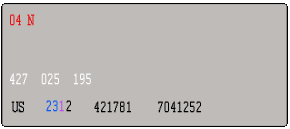
|
|
The Panel Van is very similar to the Kombi, except that it has no side windows, and it
has a vertical partition wall behind the front seats, to separate the cab area from
the cargo area. The Panel Van was definately designed to be a "commercial" model
for transporting cargo only. Interior knobs were usually black instead of ivory and
the cab area was "upholstered" with simple grey masonite-type panels instead of cloth
or vinyl. The cargo area was usually just plain grey primered metal.
|
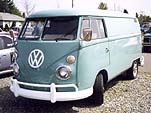
|
|
Panel Van (Type 21) |
| Type Code |
Steering |
Cargo Doors |
Special Options |
| |
| 211 |
Left |
Right Side |
- |
| 213 |
Left |
Left Side |
- |
| 214 |
Right |
Left Side |
- |
| 215 |
Left |
Both Sides |
- |
| 216 |
Right |
Both Sides |
- |
The Microbus; 9 Passenger, also known as an "11 window bus, was essentially a Kombi with a much
nicer interior (vinyl or cloth instead of the grey masonite) and 2-tone
exterior paint choices. Like the Kombi, the rear seats could be removed, but the
Microbus was primarily designed to carry passengers, not cargo. The 9-passenger Microbus
has a "bulkhead" front bench seat and the middle and rear seats are also full bench seats,
enabling 9 people to travel in style!
|
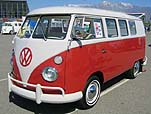
|
|
Microbus 9-Passenger (Type 22) |
| Type Code |
Steering |
Cargo Doors |
Special Options |
| |
| 221 |
Left |
Right Side |
- |
| 223 |
Left |
Left Side |
- |
| 224 |
Right |
Left Side |
- |
| 225 |
Left |
Right Side |
Sliding Sunroof |
| 228 |
Right |
Left Side |
Sliding Sunroof |
The Kombi, also known as a "standard bus" or an "11 window bus, was Volkswagen's
entry-level passenger bus. Volkswagen used the name "Kombi" to describe the fact
that this model was a "Kombination" vehicle that could carry passengers
(when the back seats were in place) or cargo (with the back seats removed).
The Kombi was a simple vehicle that was outfitted very similar to the Panel Van,
with an interior covered in grey masonite-type panels instead of vinyl or cloth.
Most camper conversions (Westfalia, Sundial, Riviera...) were based on the Kombi model.
|

|
|
Kombi (Type 23) |
| Type Code |
Steering |
Cargo Doors |
Special Options |
| |
| 231 |
Left |
Right Side |
- |
| 233 |
Left |
Left Side |
- |
| 234 |
Right |
Left Side |
- |
| 235 |
Left |
Right Side |
Sliding Sunroof |
| 237 |
Left |
Left Side |
Sliding Sunroof |
| 238 |
Right |
Left Side |
Sliding Sunroof |
The Deluxe Microbus; 9 Passenger,
The Deluxe Microbus was Volkwagen's top-of-the-line transporter. The Deluxe was essentially a
normal Microbus with an extra window added to each side (plus very cool curved windows
added to each back corner through model year 1963). The Deluxe
Microbus also had fancy trim attached to the exterior, that consisted of flat polished
aluminum moulding that held a colored plastic bead down it's center, as well as fancy
rubber trim affixed to the face of the bumpers, front and rear. Most Deluxe Microbuses
were ordered as "Samba" models (a $160 option for 1963), that included a sliding canvas sunroof flanked by
4 skylight windows on each side of the roof (that's a "23" window bus through model year 1963,
and a "21" window bus starting in model year 1964). When ordering their new bus,
a customer could specify M-code "M130", if they wanted their new Deluxe Microbus to be a
"hardtop" model without the Samba's sliding sunroof and 8 skylights. These "hardtop"
Deluxe Microbuses are rarer than the Samba version, and are often called
"13" window buses ("15" window buses through model year 1963). The 9-passenger version
has a "bulkhead" front bench seat and the middle and rear seats are also full bench seats,
accomodating a total of 9 passengers, including the driver.
|
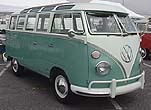
|
|
|
"Samba" Deluxe Microbus |
|

|
|
|
"Hardtop" Deluxe Microbus |
|
|
|
Deluxe Microbus 9-Passenger (Type 24) |
| Type Code |
Steering |
Cargo Doors |
Special Options |
| |
| 241 |
Left |
Right Side |
- |
| 242 |
Right |
Left Side |
- |
The Deluxe Microbus; 7 Passenger,
The Deluxe Microbus was Volkwagen's top-of-the-line transporter. The Deluxe was essentially a
normal Microbus with an extra window added to each side (plus very cool curved windows
added to each back corner through model year 1963). The Deluxe
Microbus also had fancy trim attached to the exterior, that consisted of flat polished
aluminum moulding that held a colored plastic bead down it's center, as well as fancy
rubber trim affixed to the face of the bumpers, front and rear. Most Deluxe Microbuses
were ordered as "Samba" models (a $160 option for 1963), that included a sliding canvas sunroof flanked by
4 skylight windows on each side of the roof (that's a "23" window bus through model year 1963,
and a "21" window bus starting in model year 1964). When ordering their new bus,
a customer could specify M-code "M130", if they wanted their new Deluxe Microbus to be a
"hardtop" model without the Samba's sliding sunroof and 8 skylights. These "hardtop"
Deluxe Microbuses are rarer than the Samba version, and are often called
"13" window buses ("15" window buses through model year 1963). In the 7-passenger version,
the back seat is a full bench seat, but the front seat is a "walk-thru" configuration,
and the middle seat is only 2/3rds length to allow access to the back seats, from the front seats.
|

|
|
|
"Samba" Deluxe Microbus |
|

|
|
|
"Hardtop" Deluxe Microbus |
|
|
|
Deluxe Microbus 7-Passenger (Type 25) |
| Type Code |
Steering |
Cargo Doors |
Special Options |
| |
| 251 |
Left |
Right Side |
- |
Single and Double Cab Pickups,
The Single Cab is a standard pickup truck based on the Transporter platform. Being a
commercial vehicle, the interior is very similar to the Panel Van, with a single bench seat
for the driver and passenger, and trimmed out with black (instead of ivory or beige) dash knobs.
But unlike virtually all other pickups marketed at the time, the Volkswagen pickup's
side and rear panels surrounding the bed, hinge down for easier loading. Long oak strips
were bolted to the corrugated bed to cushion the metal surface from heavy loads.
For further utility, the entire area underneath the bed (between the cab and the engine
compartment) was available for securily storing tools and materials, and was accessed by a lockable
door on the side. Starting in November 1958, Volkswagen also offered the Double Cab pickup.
The Double Cab was essentially a Single Cab pickup with the back wall extended to make room for
another bench seat that could accomodate 3 more passengers. An additional side door on each side provided
access to this back seat. Since both pickups share the standard transporter drivetrain and
wheelbase, the Double Cab's pickup bed and side gates are shortened versions of the Single Cab's, to compensate
for the extended cab. Like the Single Cab, the Double Cab also includes the secured storage
compartment under the pickup bed.
|
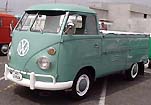
|
|
|
Single Cab Pickup |
|
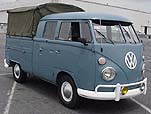
|
|
|
Double Cab Pickup |
|
|
|
Single and Double Cab Pickups (Type 26) |
| Type Code |
Steering |
Cargo Doors |
Special Options |
| |
| 261 |
Left |
Single Cab |
Storage door on Right |
| 263 |
Left |
Single Cab |
Storage Door on Left |
| 264 |
Right |
Single Cab |
Storage Door on Left |
| 265 |
Left |
Double Cab |
Rear door on Right |
| 267 |
Left |
Double Cab |
Rear door on Left |
| 268 |
Right |
Double Cab |
Rear door on Left |
Ambulance; This is a special purpose vehicle built for hospitals,
ambulance companies, sanatoriums, etc. The ambulance (or "Krankenwagen") is essentially a Kombi
modified for the customer based on a long list of possible optional equipment, including; a
special fold-down rear hatch, rails for a stretcher, hooks for intravenous bottles, cabinets
for medicine and supplies, siren and blue roof light, etc.).
|
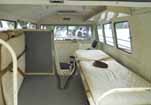
|
|
Ambulance (Type 27) |
| Type Code |
Steering |
Cargo Doors |
Special Options |
| |
| 271 |
Left |
Right Side |
- |
| 273 |
Left |
Left Side |
- |
| 274 |
Right |
Left Side |
- |
The Microbus; 7 Passenger, also known as an "11 window bus,
was essentially a Kombi
with a much nicer interior (vinyl or cloth instead of the grey masonite) and 2-tone
exterior paint choices. Like the Kombi, the rear seats could be removed, but the
Microbus was primarily designed to carry passengers, not cargo. In the 7-passenger Microbus,
the back seat is a full bench seat, but the front seat is a "walk-thru" configuration,
and the middle seat is only 2/3rds length to allow access to the back seats, from the front seats.
|

|
|
Microbus 7-Passenger (Type 28) |
| Type Code |
Steering |
Cargo Doors |
Special Options |
| |
| 281 |
Left |
Right Side |
- |
| 285 |
Left |
Right Side |
Sliding Sunroof |
|
|
|
Copyright © 2006- BusTopia.com
- All content contained within this site is the property of BusTopia.com, and may not
be copied or reproduced by anyone for any purpose, without explicit
permission from BusTopia.com.
This site is not affiliated with or endorsed by Volkswagen Werk AG
or Volkswagen of North America.
VW, VOLKSWAGEN, GHIA and BEETLE are Registered Trademarks of Volkswagen Werk AG and Volkswagen of North America.
|
|
|
|